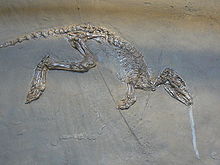Leptictida (leptos iktis "small/slender weasel") is a possibly paraphyletic extinct order of eutherian mammals. Their classification is contentious: according to cladistic studies, they may be (distantly) related to Euarchontoglires (rodents, primates and their relatives), although they are more recently regarded as the first branch to split from basal eutherians.[2] One recent large-scale cladistic analysis of eutherian mammals favored lepictidans as close to the placental crown-clade;[3] and several other recent analyses that included data from Cretaceous non-eutherian mammals found Leptictis to belong to the superorder Afrotheria.[4]
You can help expand this article with text translated from the corresponding article in Italian. (April 2019) Click [show] for important translation instructions.
|
| Leptictidans Temporal range: Late Cretaceous - Oligocene
Possible descendant taxon Placentalia survives to present | |
|---|---|
 | |
| Fossil specimen of Leptictidium auderiense | |
| Scientific classification | |
| Domain: | Eukaryota |
| Kingdom: | Animalia |
| Phylum: | Chordata |
| Class: | Mammalia |
| Clade: | Eutheria |
| Order: | †Leptictida McKenna, 1975 |
| Subgroups[1] | |
| |
The most recent phylogenetic studies recover it as actually a paraphyletic assemblage leading to Placentalia.[5]
Description
The leptictids are a characteristic example of the non-specialized placental mammals that took part in the late Cretaceous-Paleocene evolutionary radiation, originally bunched together in the order Insectivora. The leptictids became extinct during the Oligocene. Their archaic cranium and dentition make it difficult to determine their relationship to other groups. Leptictid postcranial anatomy has been studied from the well-preserved middle Eocene Leptictidium specimens found at Messel, Germany.[6]
Judging from these specimens, lepticids were small placentals with a body length ranging from 60 to 90 cm (24 to 35 in). The head had a long and slender snout, probably featuring a short trunk, which may have been used for scratching the undergrowth in search of insects and worms. The mouth's archaic dentition included two or three incisors, a canine, and V-shaped cheek-teeth - four premolars and three molars.[6]
Their forelegs were shortened, but their hind legs were elongated. While this anatomy is reminiscent of small kangaroos and jerboas, suggesting a jumping locomotion, the structure of the tarsal bones hints at a specialization for terrestrial running. Perhaps these animals were capable of both modes of locomotion; running slowly in search for food, and jumping quickly to avoid threats. Additionally, the Messel specimens feature a surprisingly long tail, unique among modern placental mammals, formed by 40 vertebrae and probably used for balance.[6]
Classification
- Order Leptictida
- Family Gypsonictopidae
- Genus Gypsonictops
- Genus Sikuomys
- Family Leptictidae
- Genus Amphigyion
- Genus Gallolestes
- Genus Labes
- Genus Lainodon
- Genus Leptonysson
- Genus Palaeictops
- Genus Praolestes
- Genus Wania
- Subfamily Leptictinae
- Genus Blacktops
- Genus Ictopidium
- Genus Leptictis
- Genus Myrmecoboides
- Genus Ongghonia
- Genus Prodiacodon
- Genus Protictops
- Family Pseudorhyncocyonidae
- Genus Diaphyodectes
- Genus Leptictidium
- Genus Phakodon
- Genus Pseudorhyncocyon
- Family Gypsonictopidae
Notes
References
Further reading
External links
Wikiwand in your browser!
Seamless Wikipedia browsing. On steroids.
Every time you click a link to Wikipedia, Wiktionary or Wikiquote in your browser's search results, it will show the modern Wikiwand interface.
Wikiwand extension is a five stars, simple, with minimum permission required to keep your browsing private, safe and transparent.
